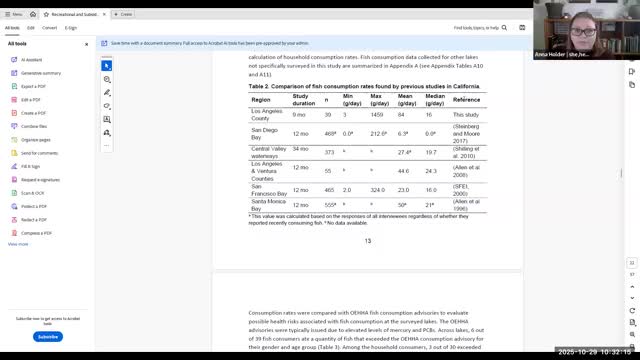State grants have posted hundreds of site‑specific fish advisory signs under AB 762; program seeks roughly $900,000 to finish statewide postings
October 29, 2025 | California Water Quality Monitoring Council, Boards and Commissions, Executive, California
This article was created by AI summarizing key points discussed. AI makes mistakes, so for full details and context, please refer to the video of the full meeting. Please report any errors so we can fix them. Report an error »

SACRAMENTO — The State Water Resources Control Board’s AB 762 grant program has helped local agencies install hundreds of site‑specific fish consumption advisory signs, but a recent program update identifies dozens of water bodies that still lack required postings and estimates additional funding needs.
Angie Norda, manager for the fish and shellfish consumption advisories grant in the Division of Financial Assistance, provided the update to the California Water Quality Monitoring Council safety work group on Oct. 29, 2025. The grant program reimburses eligible local agencies and nonprofit partners for posting site‑specific OEHHA advisories.
Key points
- Round 1: Under an agreement with the California Conference of Directors of Environmental Health (CCDEH), approximately $213,000 was reimbursed to 22 local agencies; the reporting sheet indicates about 665 signs installed at 68 water bodies.
- Round 2: Awards totaling approximately $83,000 were issued to nine agencies; installations were complete as of the meeting and final reimbursement requests were pending.
- Program update: CCDEH’s draft program update, prepared for the state board, lists roughly 97 water bodies with no posted signs and 12 with only partial postings. The draft estimates that completing the statute’s posting requirements would cost about $900,000 (this estimate includes CCDEH and agency costs).
Policy detail and constraints
AB 762 requires site‑specific posting when OEHHA issues a site‑specific advisory; the statute and the existing grant agreement do not permit reimbursement for statewide advisories. The program also requires that agencies install signs before seeking reimbursement, so replacement stockpiles are generally not reimbursable in advance.
Implementation and next steps
Norda said the initial agreement (with CCDEH) will end early next year; the board is preparing a new three‑year agreement designed to support annual funding rounds and predictable application schedules, with a goal of opening a third round in mid‑2026. Work group members proposed mapping sign locations and long‑term replacement needs; Anna Holder suggested integrating sign locations into the planned fish consumption app.
What officials said
Angie Norda, Division of Financial Assistance: “Round 1 reimbursed approximately $213,000 to 22 local agencies, and approximately 665 signs were installed at 68 water bodies.”
The work group discussed damaged or missing signs and the difficulty local agencies face when reimbursement is contingent on physical installation. Local staff noted that some agencies did not initially realize all required sites needed postings and that replacement funding is important for wear, vandalism and evolving advisories.
Angie Norda, manager for the fish and shellfish consumption advisories grant in the Division of Financial Assistance, provided the update to the California Water Quality Monitoring Council safety work group on Oct. 29, 2025. The grant program reimburses eligible local agencies and nonprofit partners for posting site‑specific OEHHA advisories.
Key points
- Round 1: Under an agreement with the California Conference of Directors of Environmental Health (CCDEH), approximately $213,000 was reimbursed to 22 local agencies; the reporting sheet indicates about 665 signs installed at 68 water bodies.
- Round 2: Awards totaling approximately $83,000 were issued to nine agencies; installations were complete as of the meeting and final reimbursement requests were pending.
- Program update: CCDEH’s draft program update, prepared for the state board, lists roughly 97 water bodies with no posted signs and 12 with only partial postings. The draft estimates that completing the statute’s posting requirements would cost about $900,000 (this estimate includes CCDEH and agency costs).
Policy detail and constraints
AB 762 requires site‑specific posting when OEHHA issues a site‑specific advisory; the statute and the existing grant agreement do not permit reimbursement for statewide advisories. The program also requires that agencies install signs before seeking reimbursement, so replacement stockpiles are generally not reimbursable in advance.
Implementation and next steps
Norda said the initial agreement (with CCDEH) will end early next year; the board is preparing a new three‑year agreement designed to support annual funding rounds and predictable application schedules, with a goal of opening a third round in mid‑2026. Work group members proposed mapping sign locations and long‑term replacement needs; Anna Holder suggested integrating sign locations into the planned fish consumption app.
What officials said
Angie Norda, Division of Financial Assistance: “Round 1 reimbursed approximately $213,000 to 22 local agencies, and approximately 665 signs were installed at 68 water bodies.”
The work group discussed damaged or missing signs and the difficulty local agencies face when reimbursement is contingent on physical installation. Local staff noted that some agencies did not initially realize all required sites needed postings and that replacement funding is important for wear, vandalism and evolving advisories.
View the Full Meeting & All Its Details
This article offers just a summary. Unlock complete video, transcripts, and insights as a Founder Member.
✓
Watch full, unedited meeting videos
✓
Search every word spoken in unlimited transcripts
✓
AI summaries & real-time alerts (all government levels)
✓
Permanent access to expanding government content
30-day money-back guarantee

